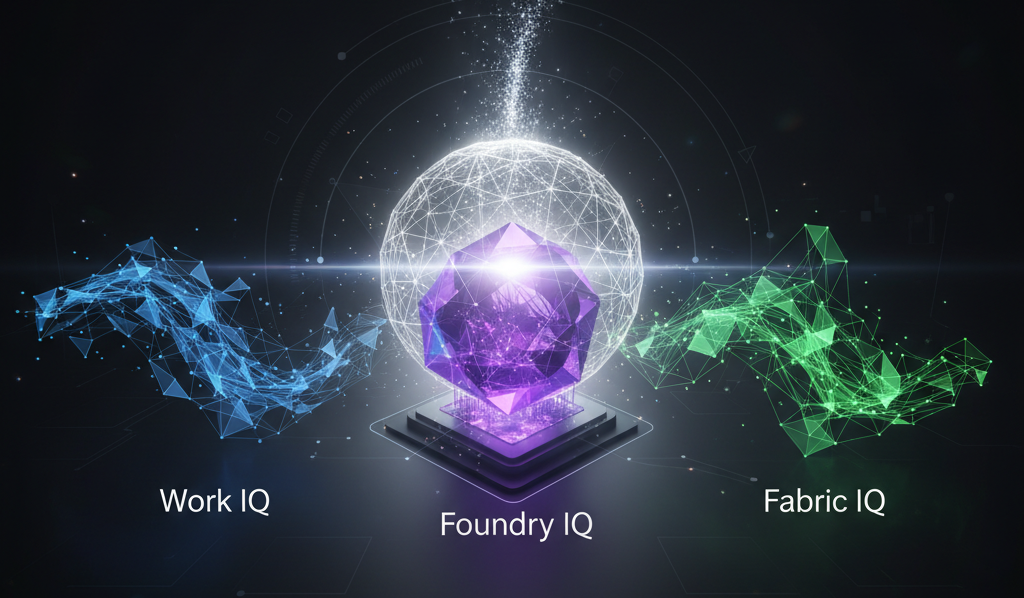Understanding Work IQ, Fabric IQ, and Foundry IQ

At the recent Ignite 2025 conference, Microsoft announced Work IQ, Fabric IQ, and Foundry IQ. While these might sound like new products, they are really formalizing a foundational layer in their cloud services architecture, which will be the intelligence layer powering future AI solutions. While you could use these in isolation, together they are combined to be a shared intelligence layer that spans business data, documents, communications, and enterprise knowledge.
I couldn't find a good write-up on all three together, so here's some notes and my take in one place to help understand each of these key components.
Work IQ
Work IQ brings the knowledge from Microsoft 365, which is built from the information flowing through the organization every day, including documents, emails, and chats. Your preferences, habits and workflows make up Work IQ memory. The memory capabilities include learning your working organization versus your formal organization structure. Work IQ uses inference capabilities to connect data and memory. This process produces insights and predicts the next best action. Microsoft Apps like Teams, Outlook and Word all take advantage of Work IQ. Custom Agents leverage Work IQ to access the intelligence layer for their own grounding.
Fabric IQ
Unlike other data solutions, Fabric IQ does not replace your existing data estate. Instead, it adds a semantic intelligence layer, transforming Fabric from a unified data platform into a comprehensive intelligence platform. Let's break this down further:
- Ontology: Facilitates a shared model of business entities, relationships, and objectives using no-code visual tools.
- Semantic Model: Extends trusted BI definitions beyond analytics into operations and AI.
- Graph: Offers a native graph engine for multi-hop reasoning, providing system-wide insights.
- Data Agent: Acts as virtual analysts, answering business questions with structured meaning, adaptable using organization-specific guidelines.
- Operations Agent: Autonomous agents that reason, learn, and act in real time to advance outcomes. The agent monitors live signals across every entity. It interprets changes within the full business context and decides the best action based on policies and objectives. It then takes those actions across operational systems and learns from each result to improve future decisions. Microsoft emphasizes that this is not just flagging issues, but an agent that “runs operations”. Decisions are context-aware, grounded in shared business semantics, not raw streams. Optimization is objective-driven, balancing cost, speed, risk, and customer impact. Autonomy is governed, and humans are kept in the loop as decisions are made, so organizations control what runs automatically, what requires approval, and what is simply observed. Instead of waiting for issues to surface in reports, the agent detects risks and opportunities as they form and intervenes in time to make a difference.
Foundry IQ
Foundry IQ, now a preview capability of Microsoft Foundry, is built on Azure Search and is a culmination of the intelligence of Microsoft Cloud, your custom applications, and the web. Available directly in the Foundry portal. Knowledge bases are reusable, topic-centric collections that ground multiple agents and applications through a single API. Foundry IQ is targeted to solve the problem that every agent team must rebuild data connections, chunking logic, embeddings, routing and permissions from scratch.
The knowledge base presents a simple but sophisticated endpoint for agents to query. Building agents becomes simpler, no longer requiring a tangle of data tools stitched into every project. Define a reusable knowledge base around a topic, such as employee policies or product documentation. Then, create it in the Foundry portal. From there, any number of agents and applications can connect and be grounded with that same knowledge base.
Foundry IQ federates data across indexed and remote knowledge sources:Microsoft 365, SharePoint, Fabric IQ, OneLake, Azure Blob Storage, Azure AI Search indexes, the web, and MCP in private preview—can all contribute to the same knowledge base Foundry IQ is built on an enterprise-ready foundation with Entra ID based governance. It respects user permissions in the knowledge sources that Foundry IQ connects to, plus data classifications andsensitivity labels from Microsoft Purview are respected through the indexing and retrieval pipeline.
So what?
Microsoft's Work IQ, Fabric IQ, and Foundry IQ formalize what has been built across its various teams and unify it into a coherent architecture layer, hopefully making it easier to build intelligent solutions using an organization's full knowledge estate.
A key differentiator is Microsoft's understanding that governance, observability, and end-to-end trust must be baked into each of these components from the ground up—not bolted on as an afterthought. Because of the massive amount of enterprise data already housed in Microsoft's cloud, the ability for these IQ components to work together provides the opportunity to unlock solutions that previously would have required more custom development.
I suspect this will significantly improve the context engineering and grounding quality of agents that leverage the IQ capabilities. Rather than trying to piece together fragmented data sources for each agent project, teams can now tap into a unified intelligence layer that already understands the organization's data, relationships, and access patterns. This should result in faster agent development and improved accuracy.
That's my first impression, looking foward to digging in deeper as more information becomes available.